Zoom
Trash

Small Change - The New Yorker. At four-thirty in the afternoon on Monday, February 1, 1960, four college students sat down at the lunch counter at the Woolworth’s in downtown Greensboro, North Carolina.
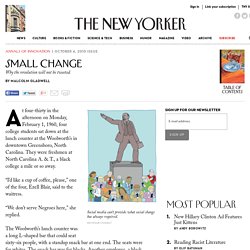
They were freshmen at North Carolina A. & T., a black college a mile or so away. “I’d like a cup of coffee, please,” one of the four, Ezell Blair, said to the waitress. “We don’t serve Negroes here,” she replied. The Woolworth’s lunch counter was a long L-shaped bar that could seat sixty-six people, with a standup snack bar at one end. The seats were for whites. By next morning, the protest had grown to twenty-seven men and four women, most from the same dormitory as the original four. By the following Monday, sit-ins had spread to Winston-Salem, twenty-five miles away, and Durham, fifty miles away. The Social Side of the Internet. The social side of the internet The internet is now deeply embedded in group and organizational life in America.
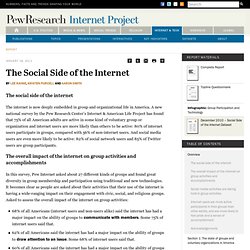
A new national survey by the Pew Research Center’s Internet & American Life Project has found that 75% of all American adults are active in some kind of voluntary group or organization and internet users are more likely than others to be active: 80% of internet users participate in groups, compared with 56% of non-internet users. Why Slacktivism Is Underrated. Katya Andresen is chief strategy officer of Network for Good, author of Robin Hood Marketing: Stealing Corporate Savvy to Sell Just Causes and blogs at nonprofitmarketingblog.com.
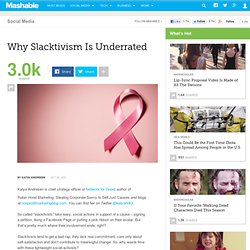
You can find her on Twitter @katyaN4G. The Rise of the Slacktivist. Is there any value in a Slacktivist?
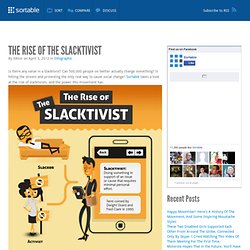
Can 500,000 people on twitter actually change something? The brave new world of slacktivism. How to be a slacktivist or an online activist. 4 part series concerning Online Activism -Part 1 Online activism in a nutshell -Andrew Gray You could argue, that activism is as old as the human race itself.
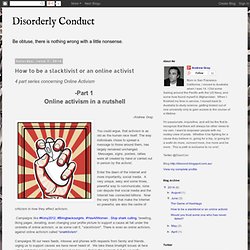
The way individuals chose to spread a message to those around them, has largely remained unchanged. Messages, signs, posters, rallies were all created by hand or carried out in person by the activist. Enter the dawn of the Internet and more importantly, social media. Campaigns fill our news feeds, inboxes and phones with requests from family and friends, urging us to support causes we have never heard of.
Does Internet Slacktivism Hurt or Help Real Activism? Slacktivism versus "Real" Activism: What's Your Opinion?
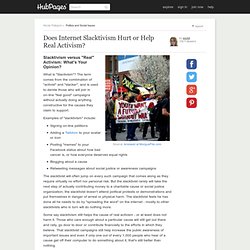
What is "Slactivism"? The term comes from the combination of "activist" and "slacker", and is used to deride those who will join in on-line "feel good" campaigns without actually doing anything constructive for the causes they claim to support. Political activities on the Internet: Slacktivism or political participation by other means?
Disorderly Conduct: How to be a slacktivist or an online activist. Slacktivism – Just One Click To Save The World? Published December 6, 2013 This article is part of our November-December focus on Cultural Shift.

Slacktivism: Raising Awareness. Does clicking a "Like" button on a web site really accomplish anything useful?
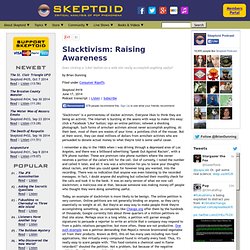
By Brian Dunning By Brian Dunning, Skeptoid Podcast Episode 419, June 17, 2014 "Slacktivism" is a portmanteau of slacker activism. Everyone likes to think they are being an activist. The Internet is bursting at the seams with ways to make this easy: click a Facebook "Like" button; sign an online petition; retweet a shocking photograph.
I remember a day in the 1980s when I was driving through a depressed area of Los Angeles, and there was a billboard advertising "Speak Out Against Racism", with a 976 phone number. Why online Slacktivism might actually be helping charities. The Power of Slacktivism. Can Slacktivism Lead to Activism? This past summer, everyone from Bill Gates to George W.
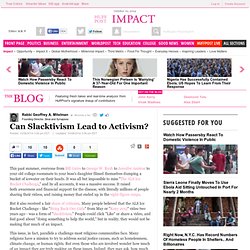
Bush to Jennifer Aniston to your old college roommate to your boss's daughter filmed themselves dumping a bucket of icewater on their heads. It was all but impossible to miss "The ALS Ice Bucket Challenge," and by all accounts, it was a massive success. It raised both awareness and financial support for the disease, with literally millions of people sharing their videos, and raising money that ended up in the eight-figure range. But it also received a fair share of criticism. #IceBucketChallenge: Why You're Not Really Helping If you've been on Facebook, Twitter or Instagram in the last week, you've probably seen it: countless videos of people dumping ice on themselves to help raise awareness of ALS.
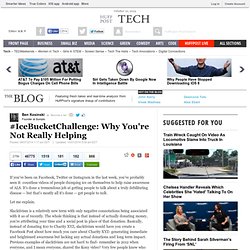
Online causes may attract more clicks than commitments. The Save Darfur Cause on Facebook had all the makings of a slam dunk cyber success. More than a million people joined the social media site’s digital movement a few years ago to save the people of Sudan’s Darfur region from mass slaughter. There was a hitch in Facebook’s humanitarian giddy-up, though: The vast majority of people who enlisted in the Save Darfur Cause recruited no one else to the digital crusade and contributed no money. The sum total of their support amounted to a computer click. “Facebook conjured an illusion of activism rather than facilitating the real thing,” sociologist Kevin Lewis of the University of California, San Diego says about the Save Darfur campaign. While the effort managed to raise nearly $100,000 after almost three years, the money came from less than 1 percent of the 1.2 million Save Darfur members.
Lewis and his collaborators analyzed records of donations and recruits at the Save Darfur Cause. NFL PLAY 60. Youth Engagement & Social Media. Does slacktivism work? An illustration, dated April 12, 2013, shows the display of a smartphone with the app logos of various social media platforms. (Jens Büttner/Picture-Alliance via DPA and Associated Press) In our information-rich world, activist and advocacy groups trying to get attention for particular causes increasingly rely on social media as a means of building support for their causes. Users are urged to “like” posts and pages on Facebook, share Twitter and blog posts with everyone they know, and to create videos or take a picture for Instagram relating to their cause.
Dairybusiness.com » ‘Fuel Up to Play 60’ campaign grows. USDA has joined a campaign to fight and defeat childhood obesity in cooperation with the NFL, National Dairy Council, multiple health organizations and several major corporations. The campaign, known as Fuel Up to Play 60, is funded with an initial private sector financial commitment of $250 million over five years by America’s dairy farmers. Funding is expected to grow as government, business, communities and families join this effort to improve nutrient-rich food choices and achieve 60 minutes of physical activity each day among children.
More than 58,000, or 60 percent, of the nation’s 96,000 private and public schools are currently enrolled in Fuel Up to Play 60.